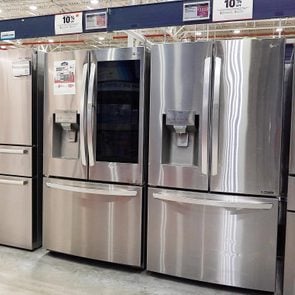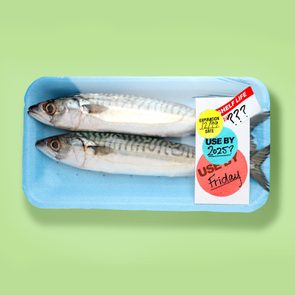How to Organize a Chest Freezer and Maximize Its Space
Updated: Jun. 02, 2024
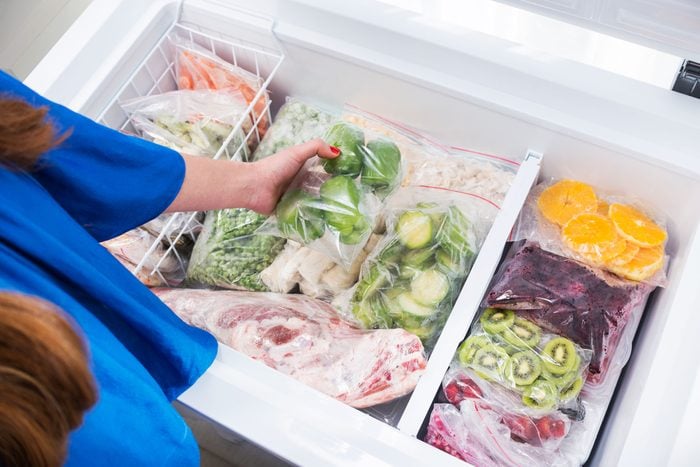
Organization for a chest freezer doesn't have to be difficult. With a few tweaks to your routine, an organized freezer can be yours.
Our editors and experts handpick every product we feature. We may earn a commission from your purchases.Learn more.
Jumbo freezers with tons of space can truly seem like a gift from the universe. They help you take advantage of grocery discounts, meal prep for the week by freezing food and stock up on all your favorite frozen bites. Yet even with the best refrigerator organizers and other tidying-up tools, organization for chest freezers can seem elusive. After all, a chest freezer resembles a wide-open abyss, and even with the best intentions, you can wind up losing the best food storage containers beneath a clutter of frozen foods.
But you don’t have to live this way. Organizing the freezer will help you grab your favorite freeze-worthy foods more easily, especially when the appliance is packed to the gills. And just like fridge organization, it’s a key component of overall kitchen organization.
Having an organized chest freezer may sound like the stuff of legends, but it’s totally attainable. These helpful (and simple) tips from home-organizing experts prove it. Read on to learn about the best organization for a chest freezer so you can have the neat and tidy appliance of your dreams.
Get Reader’s Digest’s Read Up newsletter for more organizing, cleaning, travel, tech, humor and fun facts all week long.
How to organize a chest freezer
Step 1: Acknowledge the challenge
“An organized kitchen is a very important step in streamlining your daily routine,” says Corrin McCoy, owner of Neat Method in New York City. “When organizing any kitchen space, the freezer and fridge should be two key areas of focus, with categorized systems that will make preparing any meal a breeze.”
According to Amanda Wiss, founder of the New York City–based professional organizing company Urban Clarity, people often use chest freezers to hold overflow food and bulk items. You may have the best freezer on the market, but if it’s connected to a refrigerator, it’s limited in space. Getting a separate chest freezer can save you money by allowing you to buy in bulk when more expensive meat and frozen items are on sale.
But it’s not as simple as shoving them into your chest freezer for future use. “If these items are lost in the bottom of your deep freeze, then all of these savings will actually turn into a loss, as people end up purchasing more of what they already have and/or allow food to expire before it can be used,” she says.
Start your organizational journey by recognizing the chest freezer’s tendency toward chaos and acknowledging the task ahead. Then get to work!
Step 2: Take out everything and purge
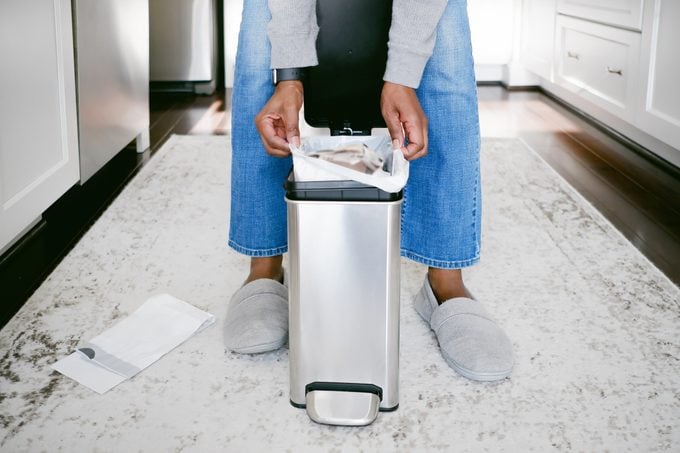
“If you’re starting with a disorganized chest freezer full of food, your next step would be to take everything out. Yes, everything!” says Wiss, who also recommends using gloves as you’re emptying the freezer to protect your hands.
As you’re pulling long-lost items out of the freezer, consider how long each food item lasts, identify which foods you’d like to keep and set aside food that’s destined for the trash. “For freezers specifically,” McCoy says, “you might have food that has expired or old leftovers that you’re able to toss, allowing you to make space for the things you really need.”
And be honest with yourself. You may have the best intentions by putting heart-healthy, cancer-fighting or otherwise nutritionist-approved foods within easy reach, but if you really won’t eat them, you’re just blocking the items you do plan to use.
For any items you’re keeping, Wiss suggests grabbing a Sharpie or a pack of freezer labels to clearly note each item’s use-by date—even if the food is prepackaged and clearly identified. “Writing your own use-by date saves you time in the future when checking your freezer,” she says. Bonus: The act of writing it yourself helps commit the date to memory and will make it more likely you’ll eat the food before it goes bad.
Step 3: Give it a good deep clean
After removing all the food, ice trays and debris from the freezer, “take the opportunity of having an empty freezer to wipe down the interior with a multipurpose cleaning spray,” says professional organizer Cassandra Aarssen, host of HGTV’s Hot Mess House and author of The Declutter Challenge. “If you’re looking for an eco-friendly, plant-based option, which is important for food storage, I like the Koala Eco Multi-Purpose Kitchen Cleaner.”
Is the interior of your freezer loaded with ice? Go a step further and defrost your freezer before cleaning and organizing it.
Step 4: Take measurements
“Your next step in organizing a freezer chest is to measure the interior of your freezer—depth, height, width—and then source your organizational products to be used inside the chest,” explains Wiss. After all, if you don’t know the dimensions you’re working with, how will you be able to organize it and maximize the space?
Use these measurements to source organizational products like chest freezer dividers and storage bins, which will turn the open void into a sectioned-off freezer in which everything—from packaged goods to leftovers—has a place. “Without these organizational products, your freezer will quickly end up back in its original disorganized state, no matter how often you try to clean it out,” Wiss says.
Step 5: Categorize the contents
After purging expired food or items with freezer burn, take a look at what you have left that you want to keep in your freezer. It’s time to organize the mess into categories, says Wiss.
“This part of the organization process will be personal to each household, their eating habits and what they choose to stock in their freezer, but some common freezer categories are ground meat, chicken/fish/steak, frozen veggies, frozen fruit, bread and frozen treats.”
McCoy adds that not only will this categorization establish an organized system, but it will also allow you “to visualize the quantity of items that you have within each group.” That way, you’ll immediately know when you’re running low on a particular item and you’re due for restocking.
Step 6: Purchase chest freezer dividers and bins
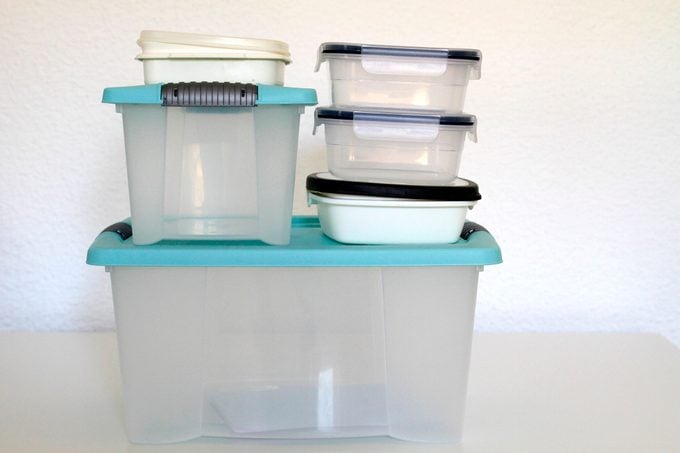
As you start your search for freezer dividers and storage containers, keep in mind the measurements you took of the freezer’s interior so that you can customize your storage for exactly what you need.
Another rule of thumb when it comes to organization for chest freezers is to choose square or rectangular containers. As Wiss notes, they’ll use the chest freezer’s right angles more efficiently than rounded-edge containers.
Go with stackable bins, she says, which make use of vertical space while allowing you to easily access items on the bottom. “Since chest freezers are quite deep, you can generally stack two storage bins high inside,” she says, suggesting these bins from Global Industrial. “A pro tip is to find appropriately sized stackable bins with handles for your specific freezer measurement so it is easy to pull up the top layer of bins to get to items on the bottom layer.”
According to McCoy, dividers are useful for corralling similar food items and avoiding losing track of what is stored on the bottom. “Deep dividers will also help prevent items from toppling over, should you choose to store them upright.”
She also encourages the use of plastic bins that group like items. “They make it easy to contain and label your categories and are also easy to wipe clean,” she says.
While you can put glass in the freezer, make sure any glass items you use are freezer safe. Glass has a tendency to crack in freezing temperatures, leading to a potentially messy situation. If you’re unsure whether a glass container is safe for the freezer, it’s best to stick with plastic storage containers.
Step 7: Label the sections
Break out the Sharpies. Unearth the label maker. Buy those freezer labels. It’s time to categorize your freezer loot. You can write directly on cardboard food packages, or stick labels to your go-to plastic or glass storage containers.
“By establishing clear categories with labels, everything that lives in your freezer from this point forward will have a dedicated space,” says McCoy. “We suggest keeping these categories broad and simple to ensure that they are easy to maintain. The more granular the categories are, the harder the upkeep becomes, which makes it harder to keep up with in the long run.”
Step 8: Maintain the order
A storage system is only successful if it is maintained, so take McCoy’s advice and “make it work for you.”
She accomplishes this by keeping like items together and subcategorizing as needed. Place your frequently used items in prime real estate locations—the top level of containers, for instance. If you mostly open the chest freezer for backups of chicken or ground beef, don’t bury those items at the bottom; make sure you store the meat front and center.
As for the products that simplify organization for chest freezers, go with your gut. “The storage solutions and organizers that you choose for your freezer should match your organization style, which is how you naturally sort and store your things,” says Aarssen, adding that these natural patterns may change over time and as your family grows and evolves.
“Don’t be afraid to tweak your system as you go,” says Wiss. “If the freezer starts to get messy again, take a moment to think about what adjustments you can make to your system.”
Ask yourself:
- Are your organizational products maximizing the interior freezer space?
- Are you overstocking the freezer?
- Are you actually using the frozen items you currently have?
- Have you checked for expired items to purge?
- Are there any items you purchased on a whim and don’t want anymore? If so, find a nearby free fridge or food pantry to donate them to!
Other tips for organizing a chest freezer
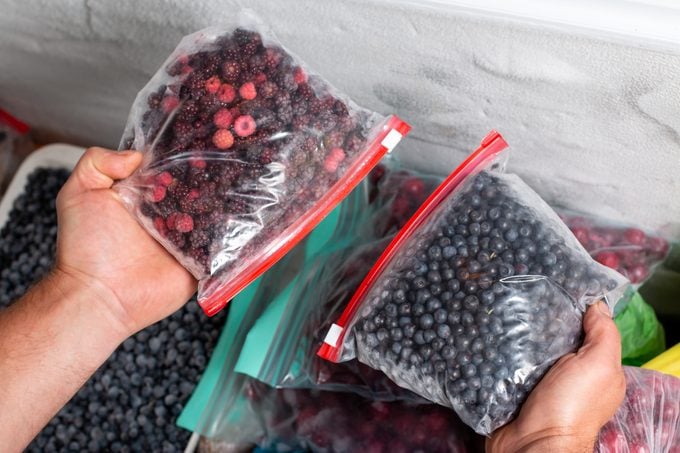
Organization for a chest freezer doesn’t have to be complex. The tips below will help you make yours neat and tidy—and keep it that way.
Be willing to say goodbye
“The most impactful thing you can do is let go of food you know you will never eat,” says Aarssen. “Saving freezer-burned [food] or food you don’t like—just in case—is only stealing space and making organizing your freezer much harder.”
Take the “first in, first out” approach
There are many theories about how best to store food. “We always like to suggest the “first in, first out” approach, encouraging clients to arrange their items according to the expiration date,” McCoy explains. “Items that are nearing their expiration date should be kept at the top to ensure that they’re used prior to going bad, and newer items can go toward the bottom.”
Stack boxes of frozen food like books
“Because you have more of a bird’s-eye view of items stored in your chest freezer than you do with a standard freezer, it’s important to file items where possible,” explains Aarssen. “For example, I like to file my frozen pizzas like I store books on a bookshelf—have the ‘bind’ facing up so you can easily see all your pizzas instead of only being able to view whatever pizza is at the top of the stack.”
You can apply this tip to any frozen foods that come in a box. Simply store them on their sides with their labels facing up, which will make it easy for you to scan down the line and pull out the item you plan to eat.
Keep decluttering
Tidying up is a constant process, so don’t assume this is a one-and-done task. Your wallet will thank you for regularly organizing your chest freezer. “Decluttering leads to less food waste in the end because nothing is lost or forgotten,” says Aarssen. A good rule of thumb—and a great cost-saver—is to take a look in your freezer before you go grocery shopping to see what you have and what meals you can whip up with its contents. Be creative!”
Shop for freezer-specific products
Make sure storage bins, dividers and other organizing products can handle freezing temperatures before you buy them. “Some may not withstand the cold temps of your freezer,” says Aarssen. “However, there are great options designed specifically for freezer storage.” She likes the YouCopia FreezeUp Freezer Bin and The Home Edit Divided Freezer Bin for food storage.
Sources:
- Corrin McCoy, owner of Neat Method in New York City
- Amanda Wiss, founder of Urban Clarity in New York City
- Cassandra Aarssen, professional organizer, host of HGTV’s Hot Mess House and author of The Declutter Challenge





















